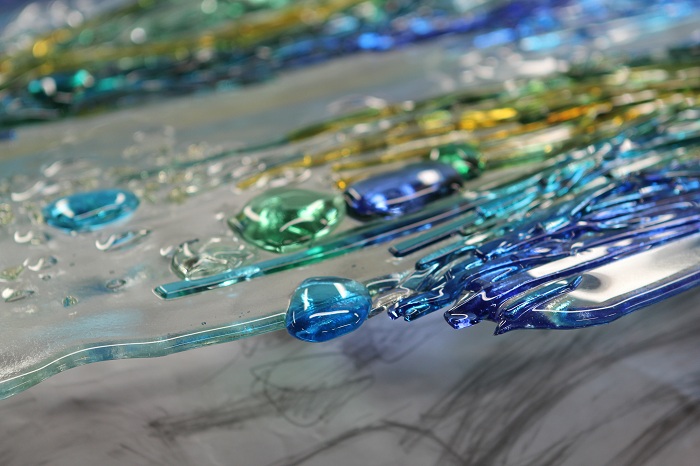Morganica wrote:Congratulations!
Thank you! Long waited, badly needed, finally installed
Morganica wrote:Where is the crack and how is it shaped? Does it follow, or appear to originate from, any of those colored pieces? In particular, the sharper-edged or taller tack-fused pieces? Is there any consistency with which colors/pieces crack?
Now with the help from other people I really think that the problem is in first firing cool down. 600 dph for 3/8 inch slab is too fast. The cracks have various shapes, one of them - S, another Y. Another panel just exploded from one point. Interesting thing about this one is that it was the only panel fired single. it took only half of the shelf. The desired effects were not reached comparatively to firings were 2 panels were fired at once. Plus it was broken badly during initial heating.
All colours are transparent and do not seem to be a problem. I did a lot of this style panels in smaller size and was always OK. The transition to larger size panels is not easy - too many things to take into account
Morganica wrote:A 2-inch thick slab of glass with tack-fused decoration on top might need a schedule typically used for glass as thick as 6 inches. Your schedules are very conservative, but if you're getting cracks around a tacked component, they still might not be conservative enough.
Not exactly, half inch slab with layers of strips and casting rocks , additional 1-1.5 inch. After final firing the overall thickness very from 1/4 to 2 inches. It is not exactly tack fuse, I would say - dimensional fuse
Morganica wrote:Are the cracks occurring at the same position in the kiln each time, or in different spots?
All different sports
Morganica wrote:This is a new (and I'd imagine much larger) kiln, so if you haven't checked the kiln for hotspots/coldspots, that's one place to look.
It was checked with cones. Seemed to be OK, but now we want to buy a few more termo couples
Morganica wrote: I have a kiln with a much smaller air volume and I periodically fire with four thermocouples in varying positions, making sure I understand the heating profile of the kiln--that might be something to think about here. There's a tech sheet on Bullseye's website, "Know your kiln" or something that like, which could be very helpful here. It would be especially important to understand if automatic venting/air movement is part of your firing strategy.
Thank you for the tip. I think that problem may be in distant position of glass from heat controller that does not reflect the actual temperatures on the shelf??? Bullseye's recommends 4 inches from the floor. I would like to use vent more, because I want air to circulate in the kiln to reach better results. Nicolas Weinstein
http://www.nikolas.net/ mentions in his lecture at Corning glass museum that it is all about air circulation around the peace and he works with way bigger peaces.

